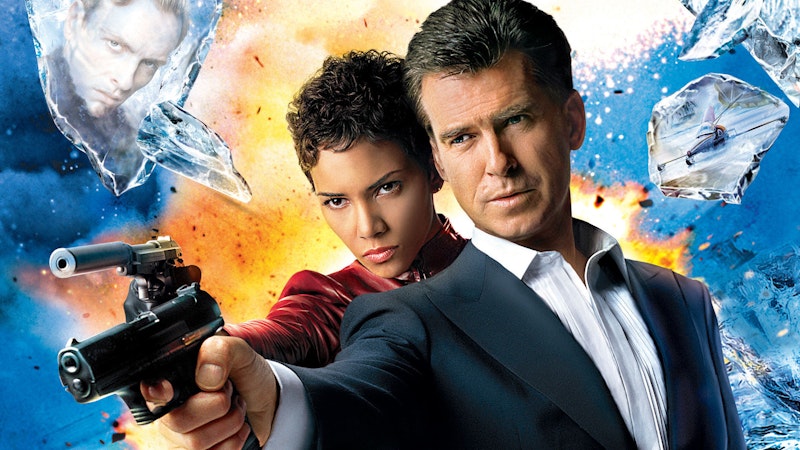The Pierce Brosnan James Bond movies are a case of diminishing returns. His fourth and last film, 2002’s Die Another Day, is easily his worst. But say this for the movie: when it’s bad it’s interestingly bad, sometimes over-the-top bad, even at moments what-am-I-watching bad. It’s not boring.
It starts when an MI6 op in North Korea to take down weapons-dealing diamond-smuggling Colonel Tan-Sun Moon goes bad, and Bond’s captured. After 14 months of torture, he’s traded for Moon’s second-in-command, Zao (Rick Yune), who’d earlier been caught in an explosion set by Bond and now as a result has small diamonds permanently embedded in his face. Bond’s held captive by MI6, who suspect he’s been brainwashed, but he breaks free and travels to Cuba following clues pointing to Zao.
After encountering NSA agent Jinx Johnson (Halle Berry), Bond tangles with Zao in a genetic lab, then follows his trail to London and mysterious billionaire Gustav Graves (Toby Stephens). Graves invites Bond to Iceland, MI6 takes Bond back, and in Iceland Bond meets Jinx again, finds out who betrayed him to North Korea, and learns the truth about Graves. There’s a sinister master plan, a satellite that can fire beams of devastating sunlight, an invisible car, and, finally, a showdown aboard a gigantic cargo plane.
The movie’s directed by Lee Tamahori, a New Zealander of Maori descent on his father’s side. It’s tempting to say the film’s concerned with whiteness and imperialism generally—that lab in Cuba can change the racial appearance of their clients, a significant plot point in the film—but while that makes for interesting subtext, the production process for a Bond blockbuster means thematic coherence is unlikely. There may be a way to argue that the movie’s subverting the Bond film formula just as imperial racial castes are subverted through Cuban technology, but that’s not where the movie lives or dies.
This is a Bond film, for the good and the bad, and if I listed the good things in it you might think there are positives enough for any movie. Halle Berry is charismatic. The diamond-faced Zao has a strong look for a Bond villain. There’s a nifty swashbuckling swordfight. Bond’s capture early on is a genuine surprise. There’s an effective oblique acknowledgment of 9/11 (“While you were away, the world changed,” M tells Bond, and that’s as much as is needed). There’s a lovely base for John Cleese’s Q in an abandoned Tube station.
And, appropriate for a film that came out on the 40th anniversary of Eon Productions’ first Bond film, it’s filled with nods to the history of the franchise and character. Ian Fleming took the name “James Bond” from the author of a book called Birds of the West Indies, and god bless this movie for putting Birds of the West Indies on screen for however brief a moment.
Unfortunately, then there’s almost everything else in the film. It looks garish, the colors slightly off, shades of teal too bright and unearthly. But the plot falls apart if you look at it funny, even more so than in most Bonds, going beyond “messy” to “ramshackle” and occasionally “arbitrary”—the characters go places and engage in action scenes because the film wants them there, not because the narrative logic’s coherent. Bond going rogue from MI6 is a nice plot point, but nothing happens as a result. He’s back in the fold far too quickly and easily.
Crucially, the tone’s slightly off. I think the Bond films are at their best when going a bit beyond reality, but this one goes too far and doesn’t pay attention to what it’s doing. I can buy Bond being issued an invisible car, but why give it to him when he’s heading to snow-bound Iceland, where the tire tracks show exactly where the car is? Before too long you’re watching Bond surfing a tsunami to escape a satellite-based solar-energy weapon and wondering if you’re watching a Bond film at all. You feel bad for Pierce Brosnan, stuck in front of a green screen, poorly composited into the action, trying to sell the danger through body language and gritted teeth.
The basic plot in the movie looks back to John Woo’s Face/Off, and an unlikely conceit is played too seriously. Even if weren’t, the James Bond films don’t work well with truly science fictional elements. There’s something about the bloody-mindedness of the character that can unify high-concept action beats and technologically implausible plot elements into a coherent story, but only within limits. Here things go much too far.
The movie’s ugly, it wastes good ideas, and the tone’s a mishmash. But if it’s ugly, it’s also colorful. And at least it has ideas to waste. You wish it had more exuberance, or maybe a sense of its own tackiness. There’s a musical cue partway through the film, when it cuts suddenly to an aerial view of London, and the Clash’s “London Calling” starts blasting. Twenty-six years after punk broke in the UK, the Bond franchise finally acknowledges its existence. And if Die Another Day were to work, it might do so as a punkish take on Bond, a trashy, loud, obnoxious, tasteless version that is to other Bond movies as early-punk was to early-rock. Bad as it is, though, I don’t think it’s bad enough or lacking in craft enough to be truly punk. If it was just a worse movie, it might be more fun.

